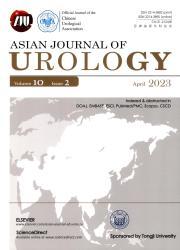Clinicopathological features and prognosis of small cell carcinoma of the urinary bladder
IF 2.4
3区 医学
Q2 UROLOGY & NEPHROLOGY
引用次数: 0
Abstract
Objective
This study aimed to investigate the clinicopathological features and prognosis of small cell carcinoma of the urinary bladder (SCCUB).
Methods
Clinicopathological data and prognosis of 24 patients with primary SCCUB treated at the Affiliated Hospital of Qingdao University (from January 2016 to December 2021) were retrospectively collected and compared with 335 patients with primary high-grade urothelial carcinoma (HG-UC) during the same period. The study endpoints were disease-free survival (DFS) and overall survival (OS).
Results
Of the 24 patients with SCCUB, 19 were male and five were female. Eight (33%) cases were pure SCCUB (pSCCUB). Sixteen (67%) cases were mixed SCCUB (mSCCUB), all of which were mixed with urothelial carcinoma. All patients underwent surgery and 13 (76%, 13/17; seven patients were lost to follow-up) patients received postoperative adjuvant chemotherapy. We found no significant difference in clinicopathological features between pSCCUB and mSCCUB. However, compared to HG-UC, SCCUB had higher lymph node metastasis (p=0.014), more lymphovascular invasion (p=0.024), higher Ki-67 expression (p<0.001), and more disease progression events (p=0.001). Median DFS and OS for SCCUB were 22 months and 38 months, respectively. The Kaplan-Meier survival curve showed that the pathological type or surgical type did not affect DFS or OS of SCCUB. However, SCCUB patients had worse DFS and OS than HG-UC patients (both p<0.05). The multivariate Cox analysis showed that the tumor size (hazard ratio 1.44, 95% CI 1.96–2.15, p=0.048) was an independent factor affecting DFS of SCCUB patients.
Conclusion
Compared with the common HG-UC, SCCUB is rare with specific clinicopathological features and a worse prognosis.
膀胱小细胞癌的临床病理特征及预后
目的探讨膀胱小细胞癌(SCCUB)的临床病理特点及预后。方法回顾性收集2016年1月至2021年12月青岛大学附属医院收治的24例原发性SCCUB患者的临床病理资料及预后,并与同期335例原发性高级别尿路上皮癌(HG-UC)患者进行比较。研究终点为无病生存期(DFS)和总生存期(OS)。结果24例SCCUB患者中,男性19例,女性5例。单纯SCCUB (pSCCUB) 8例(33%)。混合性SCCUB (mSCCUB) 16例(67%),均合并尿路上皮癌。所有患者均接受手术治疗,13例(76%,13/17,失访7例)患者接受术后辅助化疗。我们发现pSCCUB与mSCCUB的临床病理特征无显著差异。然而,与HG-UC相比,SCCUB有更高的淋巴结转移(p=0.014),更多的淋巴血管侵袭(p=0.024),更高的Ki-67表达(p<0.001)和更多的疾病进展事件(p=0.001)。SCCUB的中位DFS和OS分别为22个月和38个月。Kaplan-Meier生存曲线显示病理类型和手术类型对SCCUB的DFS和OS无影响。SCCUB患者的DFS和OS较HG-UC患者差(p < 0.05)。多因素Cox分析显示,肿瘤大小(风险比1.44,95% CI 1.96 ~ 2.15, p=0.048)是影响SCCUB患者DFS的独立因素。结论与常见的HG-UC相比,SCCUB罕见,具有特殊的临床病理特征,预后较差。
本文章由计算机程序翻译,如有差异,请以英文原文为准。
求助全文
约1分钟内获得全文
求助全文
来源期刊

Asian Journal of Urology
UROLOGY & NEPHROLOGY-
CiteScore
4.00
自引率
3.80%
发文量
100
审稿时长
4 weeks
期刊介绍:
Asian Journal of Urology (AJUR), launched in October 2014, is an international peer-reviewed Open Access journal jointly founded by Shanghai Association for Science and Technology (SAST) and Second Military Medical University (SMMU). AJUR aims to build a communication platform for international researchers to effectively share scholarly achievements. It focuses on all specialties of urology both scientifically and clinically, with article types widely covering editorials, opinions, perspectives, reviews and mini-reviews, original articles, cases reports, rapid communications, and letters, etc. Fields of particular interest to the journal including, but not limited to: • Surgical oncology • Endourology • Calculi • Female urology • Erectile dysfunction • Infertility • Pediatric urology • Renal transplantation • Reconstructive surgery • Radiology • Pathology • Neurourology.
 求助内容:
求助内容: 应助结果提醒方式:
应助结果提醒方式:


